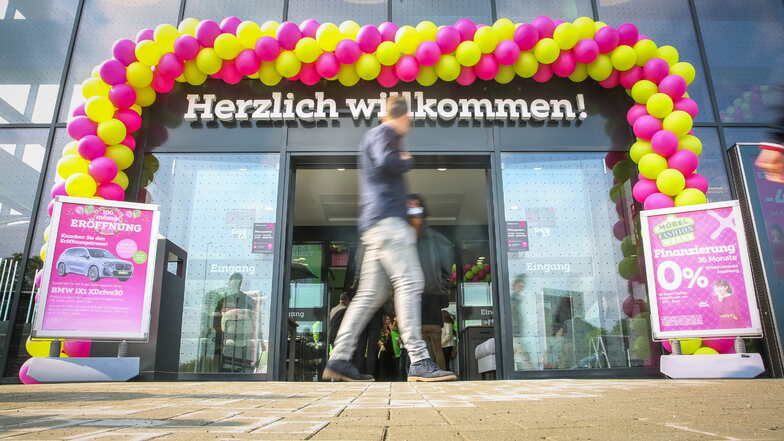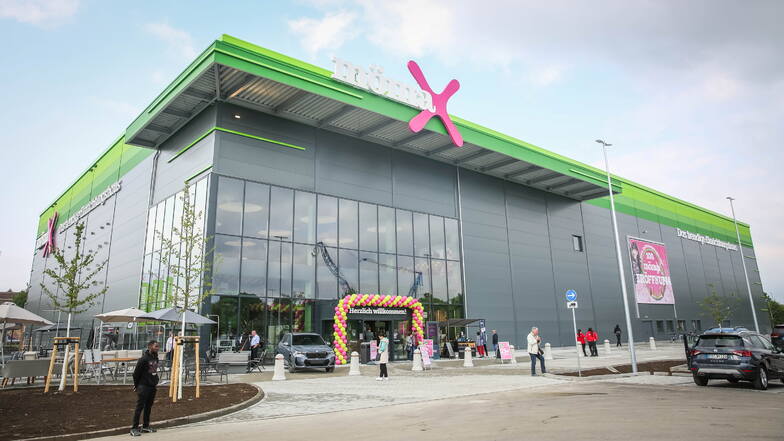From Dominique Bielmeier
Dresden. Actually, they wanted to attach the balloons in pink and light green, which were placed around the entrance door for the grand opening, to the roof as well. But since Mömax is located in the flight path to Dresden Airport, that wasn't allowed, says spokesman Florian Schmidt, somewhat amused, at the presentation of the new furniture store. After all, the first Mömax in Dresden, on Hamburger Straße, is just under half an hour's drive from the airport. It makes you wonder how far the planes are traveling. But rules are rules - and the opening after a construction period of around 1.5 years should not fail because of a few balloons.
6,500 square meters, two floors, around 40 employees: On the former wasteland between Flügelwegbrücke and the tank farm on Bremer Straße, a furniture store has been built that could compete with Ikea and Höffner. Mömax, which belongs to the Austrian XXXL Group, expects a large influx of customers, including from the surrounding area, thanks to the location, which has good transport links and 130 parking spaces (plus 76 for bicycles). But what will they find here that the competition doesn't?
Mömax in Dresden is one of only a few stores in eastern Germany
At first glance, the sales area concept of the furniture store is similar to that of Ikea in Elbepark: a few furniture groups in the bright entrance area, then an escalator leads up to the furniture exhibition, where arrows projected onto the floor show the way through the individual departments, which really cover every area of living. On the first floor you will then find the large self-service hall, smaller furniture such as shelves as well as decorative items of all kinds are available here, home textiles and more for spontaneous, quick takeaway.

The comparison with Ikea is also worthwhile in terms of the target group: Mömax also wants to appeal more to young people who don't have a bulging wallet. Or as spokesman Schmidt says several times, "We want to offer a sharp price." According to the current offer on the Mömax website, that means, for example: a small living room landscape from just under 450 euros, a sliding-door wardrobe for just under 190 euros - in the opening offer even for just 99 euros. Mömax generally promises up to 40 percent price savings on furniture until at least June 3 with a voucher from the current brochure.
The range of furniture is also different from that at Ikea, with less of a Scandinavian feel and more of a focus on design trends. It's not for nothing that Mömax calls itself a "trend furniture store. For example, sofas with corduroy upholstery and shelves made of dark metal are currently in fashion.

In the furniture exhibition, a lot of emphasis is also placed on interior design, the small exemplary living spaces are lovingly decorated down to the smallest detail, as one is used to from photos on Pinterest or Instagram. The customer should take away a good idea for his own home. There, he can then assemble all the furniture himself, just like at the competition. Unlike Ikea, however, Mömax still offers a service at the warehouse, so the customer does not have to gather the packaged goods and load them himself.
Digital price tags, but no gastronomy
For just under 40 euros, a car can be rented for three hours for transport. A delivery and assembly service also costs extra, except for kitchens. These, like sofas or bedrooms, can be planned in 3-D on the computer.
Mömax is also proud of the "completely digital pricing" of the goods and the many monitors in the store, some of which are as tall as a man and show short film sequences, for example, of the options for bedroom furnishings. The notes, paper measuring tapes and small pencils that hang next to them almost seem a bit out of date.

With the exception of a snack vending machine, the only thing you won't find in the new Mömax is food service. For this medium-sized sales area - a store in Berlin has a whole 12,000 square meters - this is not planned. Incidentally, the next Mömax is not until Halle (Saale); with the exception of the two locations in the capital, there are only three stores in total in eastern Germany.
The missing balloons on the roof are also not worth mentioning in view of the history of the new building project: The approximately two-hectare site had to be cleared at great expense due to the contaminated soil - a distribution warehouse for petrochemical products used to be located here. For more than 50 years, paints and solvents for the wholesale trade had been stored on the land until 1992, and toxic substances such as heavy metals and mineral oils had leaked into the soil. In the 1990s, the old buildings disappeared, and the area lay fallow for a good 20 years.
Criticism of Mömax settlement from the Saxony Trade Association
However, the investor did not have to bear the costs of clearing the site alone; he received financial support from the Free State: The state directorate provided a total of 1.1 million euros. The funding, which covered around 80 percent of the costs, came from the European Regional Development Fund (ERDF).
"With the subsidies amounting to a good deal of one million euros, not only will another unsightly urban wasteland in Dresden disappear," said Regina Kraushaar, president of the state directorate, in the summer of 2021, "but it will finally be possible to eradicate the serious environmental sins of the past in a commercially intensively used urban area in the middle of the state capital."
The Saxony Trade Association had voiced criticism in the past. "In our view, this area is not at all suitable for retail," said David Tobias, who is responsible for the Dresden region, in the summer of 2021, adding that the traffic load at the Flügelwegbrücke intersection was already too high at the time. "The entrances and exits will not be able to cope with the usual number of visitors and will put additional strain on the traffic situation at Bremer Straße and Hamburger Straße." (with SZ/noa)
From Wednesday, the Mömax furniture store, Hamburger Straße 46, is always open from Monday to Saturday in the period from 10 am to 7 pm.








